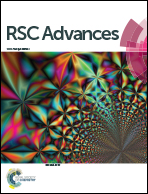A gel polymer electrolyte based on a novel synthesized matrix of a self-doped polymer of h-poly(methyl methacrylate-vinyl trismethoxy silane)
Abstract
In order to incorporate inorganic nano-particles into a gel polymer electrolyte (GPE) in the form of chemical bonds to improve electrolyte performances, monomers of methyl methacrylate (MMA) and vinyl trismethoxy silane (VTMS) were chosen to synthesize the novel self-doped polymer of h-poly(methyl methacrylate-vinyl trismethoxy silane) (h-P(MMA-VTMS)), and then the obtained polymer was used as a matrix to prepare GPE. By the characterization of the resultant polymer, the composition and structure conformed to the design concept, and the self-doped polymer is amorphous and possesses two different glass transition temperatures (Tg) and a better thermal stability. From the investigation of the prepared GPE, it is thermally stable in the temperature range from 30 °C to 100 °C and the ionic conductivity reaches the level of 10−4 S cm−1 at room temperature. For the 50 wt% GPE system, the variation in ionic conductivity displays an Arrhenius behavior in the temperature range from 30 °C to 60 °C. The higher lithium ion transference number is 0.42, the compatibility with lithium metal anode is better and the electrochemical stability is stable up to 5.2 V versus Li/Li+.


 Please wait while we load your content...
Please wait while we load your content...